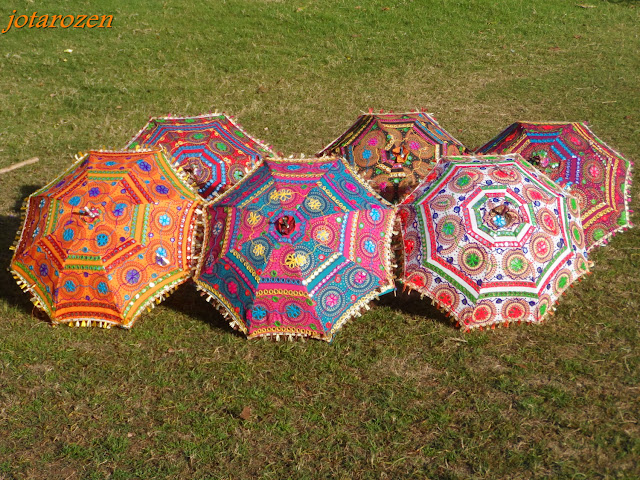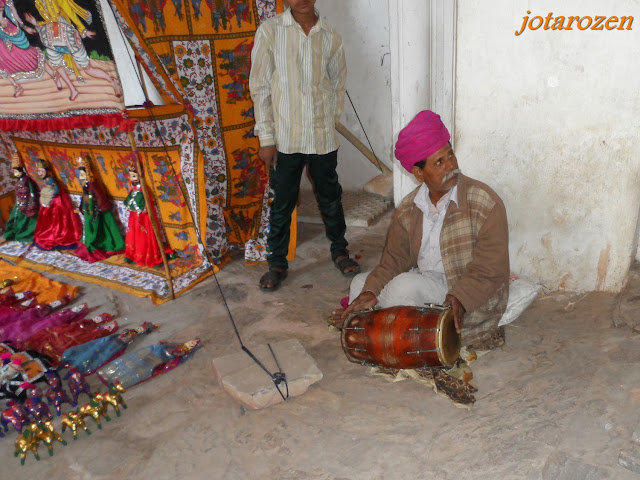Footsteps - Jotaro's Travels
Amber Fort
Jaipur, India ( A UNESCO Heritage Site) - 13th February,2013
Visiting it during the 5th day of my tour of India was one of the highlights of my trip.
A. THE RIDE UP
 |
| Long queue at Amber Fort Gardens to enter the fort. |
While waiting (up to an hour sometimes), tourists can pass their time to buy colorful parasols or souvenirs from the vendors plying the garden.
Souvenirs include nice colorfully etched brass items such as bowls, animals, etc.
In front, the elephants too were eagerly queuing up to take on their passengers.
Our turn came, up the elephant we climbed in and off we went climbing up the battlements of the fort. These battlements are part of a long protection wall straddling the perimeter hills of Jaipur.
The faces & trunks of the elephants are all colorfully painted, and they have names too!
The one who took us up was called Lucky and his mahout's name was Raj.
As we wend our way up, at the lower levels can be seen houses. Yes, locals do stay here, but I wonder if these houses must be as ancient as the fort, and the families here probably could trace their roots back to the days of the Rajasthan Empire.
Looking back, walls can be seen straddling the hills, and ...
... ahead, were more walsl snaking their way up and down the tops of hills. These walls form part of the fortification that protects the town below, with the Amber Fort forming part of this fortification.
Looking down, there is a scenic view of Maotha Lake.
I have been on many other elephant rides, like those in Thailand etc.; but this ride is really of a different experience. Amazing!
As we got nearer the walls loom over us, so tall & so vertical. It would have been a difficult task for any invaders, battling their way to up the rampart walls, then atop the ramparts and to finally meet the daunting walls.
B. THE MAIN COURTYARD
At the top of the ramparts, an large arch entrance protected by huge timber doors allow us (and more importantly the elephants) in easily.
Inside, the elephants let us down at the main courtyard inside the fort itself.
This is a very large courtyard - it must have been the place for assembly of the troops.
Surrounding this courtyard are several buildings on the next level, the first level. Like this Dewan Am (Hall of Public Audience) ...
Living quarters with balconies overlooking the courtyard.
The Maharaja's Palace.
A secondary palace.
Up on one wall is a Coat-of-Arms which states 1135 A.D., is this the founding year of the fort - then it must be close to a millennium old.
To one side, we take stairs up to the next level, the Palace Level.
C. THE PALACE LEVEL
They are several buildings at this level, the main ones are :
C.1 THE DEWAN-I-AAM (HALL OF PUBLIC AUDIENCE)
The Hall of Private Audience (Diwan-e-Khas).
This hall is very recognizable by the distinct red sandstone columns ringing its perimeter.
Columns & Arches in a row.
These columns have nicely carved capitals with detailed corbels.
And also intricately carved columns bases.
The Hall of Private Audience (Diwan-i-Khas)
Inscribed Marble Tablet giving details of the Dewan-i-Khas
Same arches, but with view outwards.
This hall is very recognizable by the distinct red sandstone columns ringing its perimeter.
Columns & Arches in a row.
These columns have nicely carved capitals with detailed corbels.
And also intricately carved columns bases.
While the outer columns are red sandstone columns, the inner ones are marble. This is where the actual hall is, with it's interestingly designed ceiling.
C.2 THE DEWAN-I-KHAS (THE HALL OF PRIVATE AUDIENCE)
The Hall of Private Audience (Diwan-i-Khas)
Inscribed Marble Tablet giving details of the Dewan-i-Khas
Unlike the Dewan Am, the Dewan Khas is constructed from marbles, with lotus-shaped column bases, and Moghul-style arches.
Same arches, but with view outwards.
C.3 THE MAHARAJA'S PALACE
The Maharaja's Palace is one of the most stunning buildings I have seen. This here is just the entrance, it does not look grandly big but leads to a large area with many rooms and even gardens another level up.
Clad in marble with semi-precious stones inlay, it looks like a well weaved carpet.
I proceeded to enter the palace, but first a look upwards to admire the ceiling. The square opening in the middle is for peeking outwards, more on that later.
Inside it was quite dim, but yet the intricacy can still be seen.
Behind was a narrow, tunnel-like darker corridor, with ramps that leads up to the upper level of the palace.
On the upper level the interior wall panels are even more intricate.
Detailed semi-precious stone in-laid wall panel.
Fine detailing of a section of the wall panel in-lay work.
An mini alcove with mirrored inlay.
And on the other side, a view below through a lattice panel.
A view from the porthole.
C.4 MAHARAJA'S PALACE - UPPER LEVELS
More intricate ceiling on the external corridor.
The upper level opens to a roof garden. This place is amazing, it unfolds layer by layer, level by level. Even here there is another level and more rooms behind those perimeter corridors.
From here, I looked upwards. To one side, with pink walls and a long balcony is the ladies' apartments. To the center is another balcony where the Maharaja can stand and select his lady for the night.
A pink dome with gold standards.
The roof garden viewed from the top.

Each wife stay in their own individual apartment, and when the Maharaja calls, the selected wife comes down from her own individual stair.
C.4 VIEW FROM THE TOP
Views from the top-most levels of the palace:
Elephants in a row on the rampart walls.
Geometric Garden in Lake Maotha.
An older fort lies further uphill.
Close up view of older fort, viewed from the battlements.
Full view of the older fort.
D. SAYING GOODBYE
The exit is through a narrow open corridor on the other side, the north side.
At the side of this corridors are shops selling books and souvenirs.
Along the way don't be surprised to meet a snake charmer or two.
Or a street pedlar of Rajastnan puppets, one that plays a drum to advertise his wares.
And paintings.

We exited the fort, there jeeps were waiting to take us back down through a rough, stony road.
The fort reflected onto Lake Maotha.
Adieu!
The fort reflected onto Lake Maotha.
Adieu!
Related Blogs :
|
 |
You may also like :
 |
| Sites : The Royal Palace, Phnom Penh, Cambodia |
 |
| Sites : The Shangrila-Dynamic Yunnan Show, China |
 |
| Sites : The Monkey Forest, Bali, Indonesia |
 |
 |
| Sites : Todaiji Temple, Nara, Japan |
 |
| Sites : Nyonya Mansion, George Town, Penang, Malaysia |
 |
| Sites : Ha Long Bay, Vietnam |
You are at - Jotaro's Blog / Footsteps / India 2013 - Sites / Amber Fort, Jaipur, India
If you like this, view my other blogs at Jotaro's Blog
(comments most welcomed below. if you like this pls share via Facebook or Twitter)






























































No comments:
Post a Comment